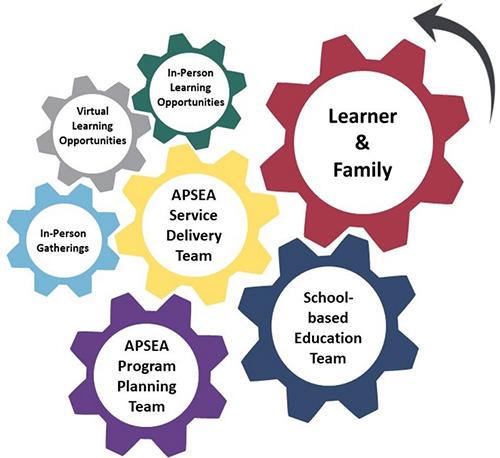(View ASL)
Responsive Teaching and Learning supports learners who are blind or visually impaired and/or Deaf or hard of hearing who qualify for APSEA support. Eligibility requirements can be found on the APSEA website (Eligibility for Service | APSEA.)
A consistent organization-wide approach to program planning is critical to support a greater degree of success in enabling students to learn and achieve. Responsive Teaching and Learning is designed to help ensure learner success in meeting educational outcomes; the development of flexible, appropriate, culturally, and linguistically responsive programs and services; and provides a consistent process across the Atlantic Provinces.
Responsive Teaching and Learning highlights the importance of professional collaboration which involves all team members in planning, implementing, and monitoring programs for learners who are BVI and/or DHH. Collaborative consultation and teamwork ensure effective and efficient service delivery. Team members work together to share goals, but not to duplicate the efforts of others. Collaboration helps support team members and provides the opportunity to learn from other's areas of expertise while keeping the learner the central focus of the plan. The role of the various APSEA team members is to contribute their knowledge and skills to support learners who are BVI and/or DHH.
Responsive Teaching and Learning requires innovative thinking to create opportunities for consultation, co‐planning, and program delivery. Professional collaboration and communication amongst the APSEA Service Delivery Team and APSEA Program Planning Team should be routinely built into employees’ schedules. This provides protected time for valuable conversations, data sharing and strategic planning that will focus on learner achievement and well-being. Responsive Teaching & Learning provides a framework to ensure that APSEA programs and services are offered through a collaborative, culturally and linguistically responsive process. The learner and their family remain the focus throughout the process. Each learner is unique, with diverse strengths and needs. Through collaborative consultation and data-informed programming decisions, Responsive Teaching & Learning supports consistent, appropriate, and flexible programming that responds to the learner as they gain new skills and knowledge in the educational setting and beyond.
